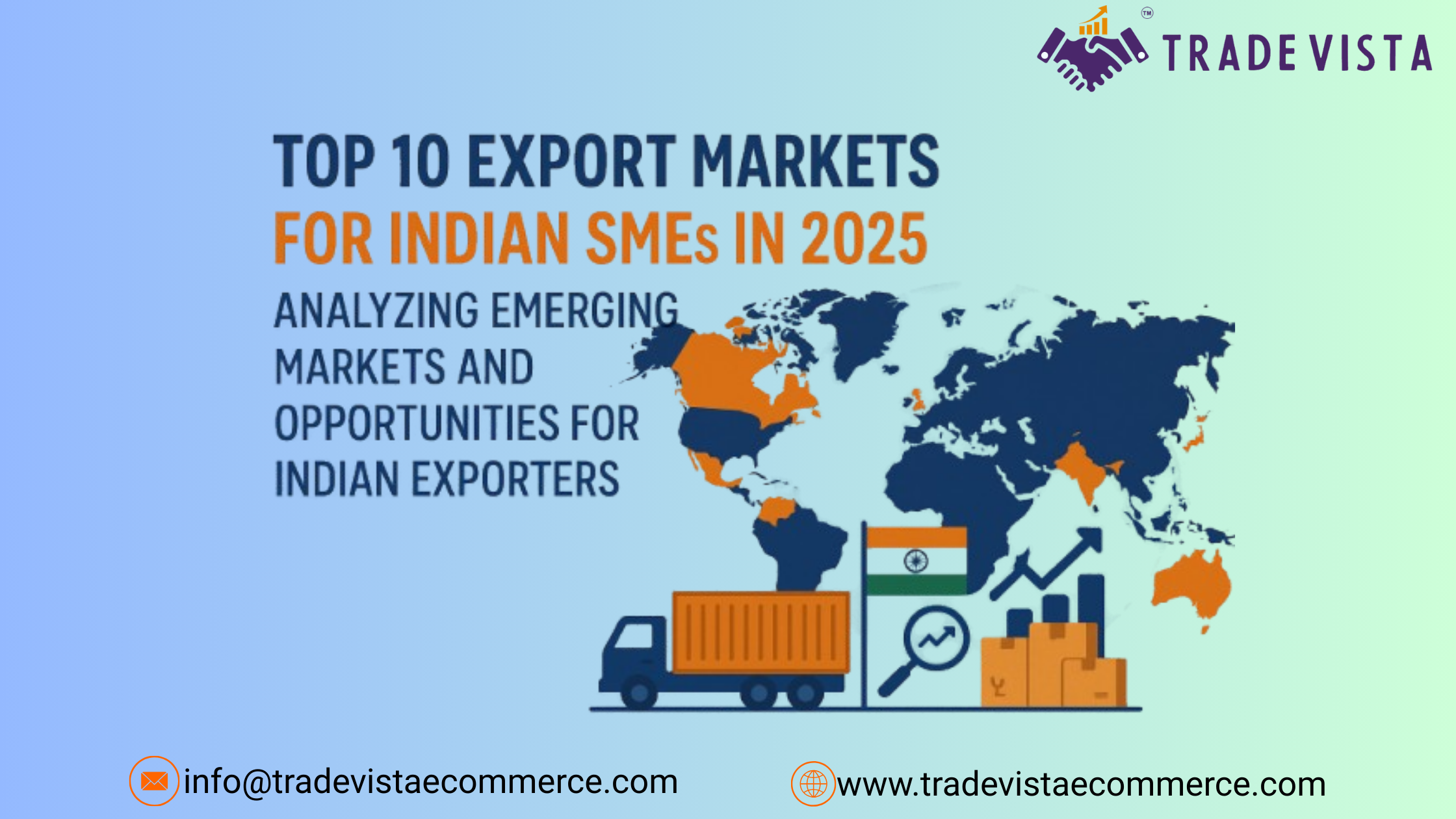In 2025, Indian small and medium enterprises (SMEs) are at a pivotal juncture in global trade. With India’s exports surpassing $820 billion in 2024–25, a nearly 6% increase over the previous year, SMEs increasingly seek to diversify their markets amid shifting geopolitical dynamics, evolving trade agreements, and emerging economies. This article delves into the top 10 export markets for Indian SMEs in 2025, highlighting key opportunities, sector-specific insights, and actionable strategies to thrive in these destinations.
1. United States
Why It Matters: The U.S. remains India’s largest export destination, accounting for over 19% of total exports from April to July 2024–25.
Opportunities:
- Electronics: Indian electronics exports to the U.S. have surged, accounting for 36% of this sector’s total exports.
- Pharmaceuticals: India’s reputation as the “pharmacy of the world” positions it well to meet U.S. demand for affordable generic medicines.
- Engineering Goods: Indian engineering products are gaining traction due to their quality and cost-effectiveness
Case Example: R R Kabel, an Indian wire and cables manufacturer, anticipates a significant surge in volume growth for fiscal 2026, primarily attributed to shifting U.S. tariff policies that have imposed higher duties on Chinese goods, making Indian exports more attractive.
2. United Kingdom
Why It Matters: The UK-India Free Trade Agreement, signed in 2025, aims to enhance bilateral trade by £25.5 billion annually by 2040.
Opportunities:
- Textiles and Apparel: 99% of Indian exports to the UK, including textiles, will become duty-free, offering a significant boost to India’s apparel industry.
- Marine Products and Leather: Tariff reductions open avenues for Indian SMEs in these sectors.
- Automotive Components: Lower tariffs on auto parts present opportunities for Indian manufacturers.
Case Example: Hero MotoCorp plans to launch electric scooters under its Vida brand in the UK and two other European countries by mid-2025, marking its entry into developed markets.
3. United Arab Emirates (UAE)
Why It Matters: The UAE is a strategic hub for Indian exports, offering access to the broader Middle East and North Africa (MENA) region.
Opportunities:
- Jewelry and Precious Stones: India’s diamond cutting and polishing expertise positions it well in the UAE market.
- Spices and Food Products: The UAE’s diverse population drives demand for Indian spices and processed foods.
- Construction Materials: Ongoing infrastructure projects in the UAE demand Indian construction materials.
Case Example: The India–Middle East–Europe Economic Corridor (IMEC), announced in 2023, aims to bolster economic development by fostering connectivity and economic integration between Asia, the Persian Gulf, and Europe, enhancing trade routes through the UAE.
4. Bangladesh
Why It Matters: Bangladesh has shown significant growth in demand for Indian products, making it a key export destination.
Opportunities:
- Textiles and Apparel: India’s cotton and silk garments are in demand.
- Pharmaceuticals: India’s affordable generic medicines cater to Bangladesh’s healthcare needs.
- Agricultural Machinery: Modernizing agriculture in Bangladesh opens avenues for Indian equipment.
Case Example: Bangladesh’s garment exports increased by 12% to $42 billion in 2024, indicating a robust textile sector that complements Indian exports.
5. Vietnam
Why It Matters: Vietnam’s rapid industrialization and participation in trade agreements like the Comprehensive and Progressive Agreement for Trans-Pacific Partnership (CPTPP) make it an attractive market.
Opportunities:
- Electronics and Auto Parts: Vietnam’s manufacturing sector requires components that Indian SMEs can supply.
- Textiles: Demand for Indian cotton and garments is rising.
- Pharmaceuticals: India’s generic medicines meet Vietnam’s healthcare demands.
Case Example: Vietnam exported $340 billion in 2024, reflecting its growing role in global trade and the potential for Indian SMEs to tap into this market.
6. Nigeria
Why It Matters: Nigeria’s urbanization and infrastructure development create demand for various Indian products.
Opportunities:
- Pharmaceuticals: India’s affordable medicines address Nigeria’s healthcare needs.
- Agricultural Machinery: Modernizing agriculture in Nigeria offers opportunities for Indian equipment.
- Food Products: Indian spices and processed foods are gaining popularity.
Case Example: India’s exports to Africa, including Nigeria, are expected to grow as non-traditional markets expand, allowing India to diversify its export portfolio.
7. Brazil
Why It Matters: Brazil has become one of India’s top export destinations, reflecting its growing importance in India’s trade strategy.
Opportunities:
- IT Services: India’s expertise supports Brazil’s digital transformation efforts.
- Machinery: Industrial growth drives demand for Indian engineering goods.
- Chemical Products: Indian chemicals are essential for agriculture and manufacturing.
Case Example: Brazil, India’s twenty-first-largest export destination between April and October 2021, is now in eighth place, indicating a significant shift in trade dynamics.
8. Germany
Why It Matters: Germany is a key player in the European Union and a significant trading partner for India.
Opportunities:
- Engineering Goods: Germany’s industrial sector requires high-quality components.
- Automotive Components: India’s auto parts can integrate into Germany’s automotive industry.
- Textiles: Indian textiles cater to Germany’s diverse consumer base.
Case Example: The India–Middle East–Europe Economic Corridor has bolstered India’s exports to Germany, enhancing connectivity and trade routes.
9. Indonesia
Why It Matters: Indonesia’s flourishing economy and diversified manufacturing base open doors for Indian SMEs.
Opportunities:
- Textiles: Indian garments meet Indonesia’s fashion demands.
- Electronics: India can supply components for Indonesia’s electronics industry.
- Furniture: High-class furniture exports from India find a market in Indonesia.
Case Example: Indonesia’s exports grew by about 14% by 2024, mainly from Asian and European markets, indicating a robust trade environment.
10. Saudi Arabia
Why It Matters: Saudi Arabia’s infrastructure projects and economic diversification create demand for various Indian products.
Opportunities:
- Jewelry: Gold and diamond jewelry from India attracts the local palate.
- Spices: Traditional spices from India cater to regional tastes.
- Construction Materials: Huge infrastructure projects depend on Indian exports.
Case Example: The India–Middle East–Europe Economic Corridor enhances trade connectivity through Saudi Arabia, facilitating Indian exports.
The global trade landscape in 2025 presents Indian SMEs with many opportunities across established and emerging markets. SMEs can effectively tap into these markets by leveraging India’s strengths in pharmaceuticals, textiles, engineering goods, and IT services. Strategic utilization of trade agreements, understanding market-specific demands, and aligning with government initiatives will be crucial in navigating the complexities of international trade.




